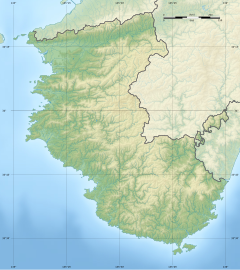Draft:Kii-Shingu Domain
 | Review waiting, please be patient.
This may take 4 months or more, since drafts are reviewed in no specific order. There are 3,108 pending submissions waiting for review.
Where to get help
How to improve a draft
You can also browse Wikipedia:Featured articles and Wikipedia:Good articles to find examples of Wikipedia's best writing on topics similar to your proposed article. Improving your odds of a speedy review To improve your odds of a faster review, tag your draft with relevant WikiProject tags using the button below. This will let reviewers know a new draft has been submitted in their area of interest. For instance, if you wrote about a female astronomer, you would want to add the Biography, Astronomy, and Women scientists tags. Editor resources
Reviewer tools
|
This article has multiple issues. Please help improve it or discuss these issues on the talk page. (Learn how and when to remove these template messages)
|
The Kii-Shingū Domain[1] (紀伊新宮藩, Kii-Shingū-han) governed the area of present-day Shingū City in Wakayama Prefecture, historically part of Kii Province[2]. The administrative center of the domain was located at Shingū Castle[3] in Shingū City. The Mizuno clan[4], who served as chief retainers of the Wakayama Domain[5], ruled the Kii-Shingū Domain, which was assessed at 35,000 koku
| Kii-Shingū Domain 紀伊新宮藩 | |
|---|---|
| Domain of Japan | |
| 1600–1871 | |
Mon of the Mizuno clan
| |
 Main enclosure of Shingū Castle | |
| Capital | Shingū Castle |
| Area | |
| • Coordinates | 33°43′47.7″N 135°59′32.9″E / 33.729917°N 135.992472°E |
| • Type | Daimyō |
| Historical era | Edo period |
• Established | 1600 |
• Disestablished | 1871 |
| Today part of | Wakayama Prefecture |


History[edit]
During the Sengoku period, the Kii-Shingū Domain was controlled by Horiuchi Ujiyoshi, a vassal of the Toyotomi clan[6]. After the Battle of Sekigahara[7] in 1600, control of the domain shifted to the Western Army.
Under the shogunate system, the Mizuno clan served as vassals to the Tokugawa clan[8] rather than as daimyos. The Mizuno clan played a significant role in the domain's politics as chief retainers for several generations.
When the Wakayama Domain of the Tokugawa Gosanke[9] directly controlled the Chigyo, residents of present-day Kimoto-cho in Kumano City, Mie Prefecture, strongly opposed it. Yoshida Shodayu, a feudal retainer at the time, endeavored to change the Chigyo. He is commemorated at Kimoto Shrine for his efforts.
Holdings at the end of the Edo period[edit]
- Kii Province
- Nagusa County - 1 village
- Arita County - 3 villages
- Hidaka County - 2 villages
- Muro County - 142 villages
List of daimyōs[edit]
# Name Tenure Courtesy title Court Rank kokudaka  Asano clan, 1600 - 1619 (Tozama daimyo)
Asano clan, 1600 - 1619 (Tozama daimyo)
1 Asano Tadayoshi (浅野忠吉) 1600 - 1619 Ukon-Daibu (右近大夫) Junior 5th Rank, Lower Grade (従五位下) 28,000 koku  Mizuno clan, 1619 - 1871 (Fudai daimyo)
Mizuno clan, 1619 - 1871 (Fudai daimyo)
1 Mizuno Shigenaka (水野重央) 1619 - 1621 Mamoru-Izumo (守る出雲) Junior 5th Rank, Lower Grade (従五位下) 35,000 koku 2 Mizuno Shigeyoshi (水野重良) 1623 - 1658 Mamoru-Awaji (守る淡路) Junior 5th Rank, Lower Grade (従五位下) 35,000 koku 3 Mizuno Shigetaka (水野重上) 1658 - 1707 Mamoru-Tosa (土佐守) Junior 5th Rank, Lower Grade (従五位下) 35,000 koku 4 Mizuno Shigetoki (水野重期) 1707 - 1714 Mamoru-Awaji (守ると差) Junior 5th Rank, Lower Grade (従五位下) 35,000 koku 5 Mizuno Tadaki (水野忠昭) 1714 - 1749 Oito (大糸) Junior 5th Rank, Lower Grade (従五位下) 35,000 koku 6 Mizuno Tadaoki (水野忠興) 1749 - 1763 Mamoru-Chikugo (筑後守) Junior 5th Rank, Lower Grade (従五位下) 35,000 koku 7 Mizuno Tadazane (水野忠実) 1763 - 1822 Mamoru-Hida (飛騨守) Junior 5th Rank, Lower Grade (従五位下) 35,000 koku 8 Mizuno Tadaaki (水野忠啓) 1822 - 1835 Mamoru-Tosa (土佐守) Junior 5th Rank, Lower Grade (従五位下) 35,000 koku 9 Mizuno Tadao (水野忠央) 1835 - 1860 Mamoru-Tosa (土佐守) Junior 5th Rank, Lower Grade (従五位下) 35,000 koku 10 Mizuno Tadamoto (水野忠幹) 1860 - 1871 Oito (大糸) Junior 5th Rank, Lower Grade (従五位下) 35,000 koku
See also[edit]
References[edit]
- ^ Derdak, Thomas; Hast, Adele (1988). International Directory of Company Histories. St. James Press. ISBN 978-1-55862-059-9.
- ^ Satō, Kanzan (1983). The Japanese Sword. Kodansha International. ISBN 978-0-87011-562-2.
- ^ Glenn, Chris (2023-01-05). The Samurai Castle Master: Warlord Todo Takatora. Frontline Books. ISBN 978-1-3990-9661-4.
- ^ Japanese Biographical Index. Walter de Gruyter. 2013-02-06. ISBN 978-3-11-094798-4.
- ^ Partner, Simon (2023-12-12). Koume's World: The Life and Work of a Samurai Woman Before and After the Meiji Restoration. Columbia University Press. ISBN 978-0-231-55910-2.
- ^ JunDao, Gu (2020-06-03). The Imperial Clan of Ming Dynasty: Volume 3. Funstory. ISBN 978-1-64948-166-5.
- ^ Glenn, Chris (2021). The Battle of Sekigahara: The Greatest, Bloodiest, Most Decisive Samurai Battle Ever. Pen & Sword Books Limited. ISBN 978-1-3990-1413-7.
- ^ In60learning (2019-11-12). Tokugawa Shogunate: Final Feudal Era of Japan. Independently Published. ISBN 978-1-7078-2848-7.
{{cite book}}: CS1 maint: numeric names: authors list (link) - ^ Seigle, Cecilia Segawa; Chance, Linda H. (2014-03-28). Ooku, the Secret World of the Shogun's Women. Cambria Press. ISBN 978-1-60497-872-8.
External links[edit]
- Shingū Castle
- https://www.tripadvisor.com/Attraction_Review-g1023666-d1385142-Reviews-*Ruins_of_Shingu_Castle-Shingu_Wakayama_Prefecture_Kinki.html
- https://jcastle.info/view/Shingu_Castle



